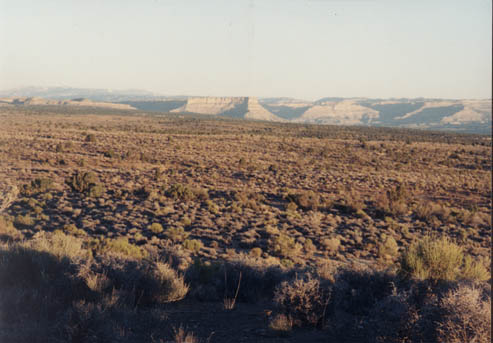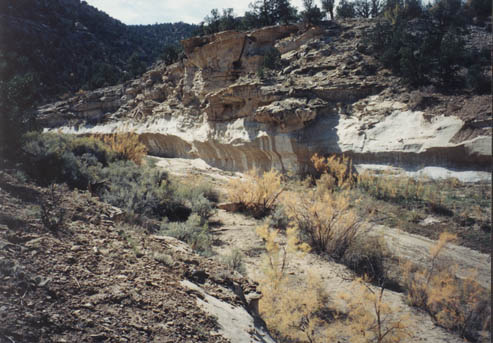
Sitting in my back yard, in the shadow of the Grand Staircase-Escalante National Monument (GSENM), now four years old, I ponder whether or not the designation by President Clinton in September of 1996 was a "good thing." After all, this was the first time in history that the Bureau of Land Management (BLM) is being asked to manage a National Monument and, since there are now several other Monumental additions to that responsibiltiy, Messrs. Babbitt and Clinton might consider some feedback.
There's some evidence of positive economic affect in my small town of Escalante--on a walk 'round town I see a new roof here and there, a new barn, some new fencework, new (American!) SUVs. There are some rather spectacular new homes going up, NOT in cookie-cutter housing projects, but on family land, personally planned and built. No teeshirt shops have appeared on Main Street. There's nothing much new for the tourists who come to town to see, or buy. One might guess that the GSENM has been a boon to the towns in southern Utah that anchor this 1.9 million acres of slickrock, slot canyons, and sandy desert uplands to the outside world. In fact, I have heard that the agency budget for the area has increased 5-fold since before the Monument was named and a good chunk of that money surely eventually falls into the bank accounts of some of the local folks, as lessees, seasonals, shop-owners, and mechanics.
Not that the local people are changing their anti-Monument, anti-government minds. The Monument increases their taxes-- property taxes have gone up because the outsiders are paying more for property, although one assumes they're buying from someone local. There are rules and regulations on land that these people have used for years, for at least three generations, for picnicking, for horseback (read: ATV) riding, and as their own. The new reservoir (see: They Eat Greens in Escalante) is the first objection to the Monument out of many mouths. There is a shortage of water. Except for the Monument, there would be a reservoir. Period.

People here are not happy with outsiders coming in to live or to visit, not happy with BLM or the staff people who are here, not happy with the federal government, the state government (Gov. Leavitt was "in on it") or the Congressional representatives. They're not happy, but prosperity is sneaking up on the people of southern Utah, due in some part to the GSENM, and there are not many who are leaving town.
If the measure of the effectiveness of the GSENM is the people whose lives are being most impacted on a daily basis, it's a wash... Times have changed the details, but this part of the country has been dependent upon the largesse of the federal government in many ways for a very long time. That won't change; I was warned long ago "not to tell us what we want" and I am not now going to insult good people by saying that despite their objections, the Monument will be good for them. Whether or not it is, is simply not the point. The Monument is on land that is now, and has always been, federal land.
The better way to determine whether Clinton did a "good thing" whether or not he is leaving a legacy he can be proud of, is to look at the larger, national picture.
If you imagine a public lands monopoly board and the Monument piece is being moved along the board from the cheap rent squares, Mediterranean Avenue to Broadway or Park Place, one could suggest that a BLM-managed Monument might be on the lower right-hand side of the board, to start with. The BLM is not an agency known for its conscientious ecosystem protection policies. Born from a wedding of the Grazing Service and the General Land Office, an agency whose principal function was to dispose of public lands, the BLM long has been beleaguered to favor the private industries that relied on public lands to wrest some profit as Americans settled the West. It wasn't until 1976 that the federal government finally decided that the lands administered by this agency were to be retained in federal ownership. (Recall that the Reagan administration acted to sell public lands to "help pay thenational debt").
No, if one were going for a certain je ne sais quoi, some class, a Monument would be National Park Service. There is a general sense that parks are for protection. No cows. (Except in Utah and Nevada!) No hunting. (Almost) no ATVs, snowmobiles, or motorized watercraft. Postcards. Collectors items. Kiosks and visitors' centers. Designated and improved camping facilities. In fact, most Monuments are managed by the National Park Service.
On the other hand, according to the Federal Land Policy and Management Act, the charge given to BLM was the "...management of the public lands and their various resource values so that they are utilized in the combination that will best meet the needs of the American people...a combination of uses that takes into account the long term needs of future generations for renewable and non-renewable resources, including, but not limited to, recreation, range, timber, minerals, watershed, wildlife and fish, and natural scenic, scientific and historical values...harmonious and coordinated management of the various resources without permanent impairment of the productivity of the land and the environment with consideration being given to the relative values of the resources and not necessarily to the combination of uses that will give the greatest economic return or the greatest unit input."
Move 6 spaces. The BLM should be able to manage a Monument, could have been preparing for this Monumental moment for the last 25 years.
A National Monument is a special area of public land set aside by Presidential Proclamation to protect objects of scientific or historic interest under the Antiquities Act of 1906. Almost every president since Teddy Roosevelt used the Act to protect the Grand Canyon has designated Monuments, to be managed by the Park Service. Only Congress can designate a National Park, or a Wilderness. The intrepid step of bringing BLM's potential for protection of the resources to the challenge of managing a unit of lands with a title on the door moves us around the corner, to a classier street.
The challenge has been taken up by BLM. Now, the devil will be found in the detail. We might lose board ground here, because the management plans are based on the Proclamation. And the Proclamation can shape the protection future of the Monument lands, or it can just paint the name on the door, with nothing behind it. Liz Thomas has discussed the newly published GSENM in the SUWA newsletter, Redrock Wilderness, Spring 2000. She begins by saying that this plan "sets a higher standard for how BLM lands all across Utah should be managed."
She goes on to say that "although the monument plan is not perfect, it is way out in front of other land management plans for BLM in Utah."
Move 3 more cautious spaces. It appears that the BLM-managed Monument is a step in the right direction, inside the document and out. Take a free roll. The Management Plan is almost a coffee-table book.
Whoops, wait. There are no grazing decisions made in the management plan. And the plan doesn't really adequately address oil and gas development, or other mineral leases, or the mining claims that currently exist on the lands within the monument.
Move back 3 big spaces! And you lose a roll!
The agency is considering a zirconium and titanium mine and processing plant right inside the Monument, in the Carcass Canyon. Noise, trucks, many trucks, 24-hour operation, and the industrial use of scarce water (remember the reservoir discussion?) is not what we would expect to find in a Monument.
The management plans are not published yet for the other, newer, BLM Monuments. Citizens' comments are being requested. Scientists are in the field, studying these rare ecosystems. And people across the country now know about some special named places because these places now have titles.
This is where we draw a card, because the fear of industrial tourism on these heretofore unspecified, un-named lands is considerable. On the other hand, now Americans will know, love, and want to protect these special places that did not have but the most basic, discretionary protection. Just as the local people have mixed feelings: they hate the tourists; they love the money. So do the environmentalists have mixed feelings: they feel non-motorized human action is less harmful than motorized; they know that more people mean more development, more trailheads, roads, signs, and less solitude and quiet. (And, they are the tourists!)

So we sit on St. James Place. Even with a well-intentioned and well-worded Proclamation, with a "step in the right direction" monument plan, and an agency that may be getting its collective wit together to protect rather than promote profit from its holdings, we are still not on Broadway. A Broadway Monument would be one where its primary function is to protect the natural resources inside its boundaries. In this Monument, there would be lots of wilderness, roadless areas would be protected, roads would be closed, there would probably not be much grazing, hunting, and absolutely no activity that would impair the sacrosanct delicacy of the natural systems.
The basis for determining whether or not any human permits would be granted would be the capacity of the land to handle the requested activity without serious impact. These Monuments would be for the land; not for the people. We're not there yet. The new National Monuments signal a change and the provide more protection, generally, than there was before the designations. They are bringing some prosperity to the small towns in proximity. More scientists and specialists are studying the systems that hold the Monuments together and make them special. But they could be much better. They could be very special places, better than Parks, as good as Wilderness...
So, the game is now more difficult, getting to be more interesting.